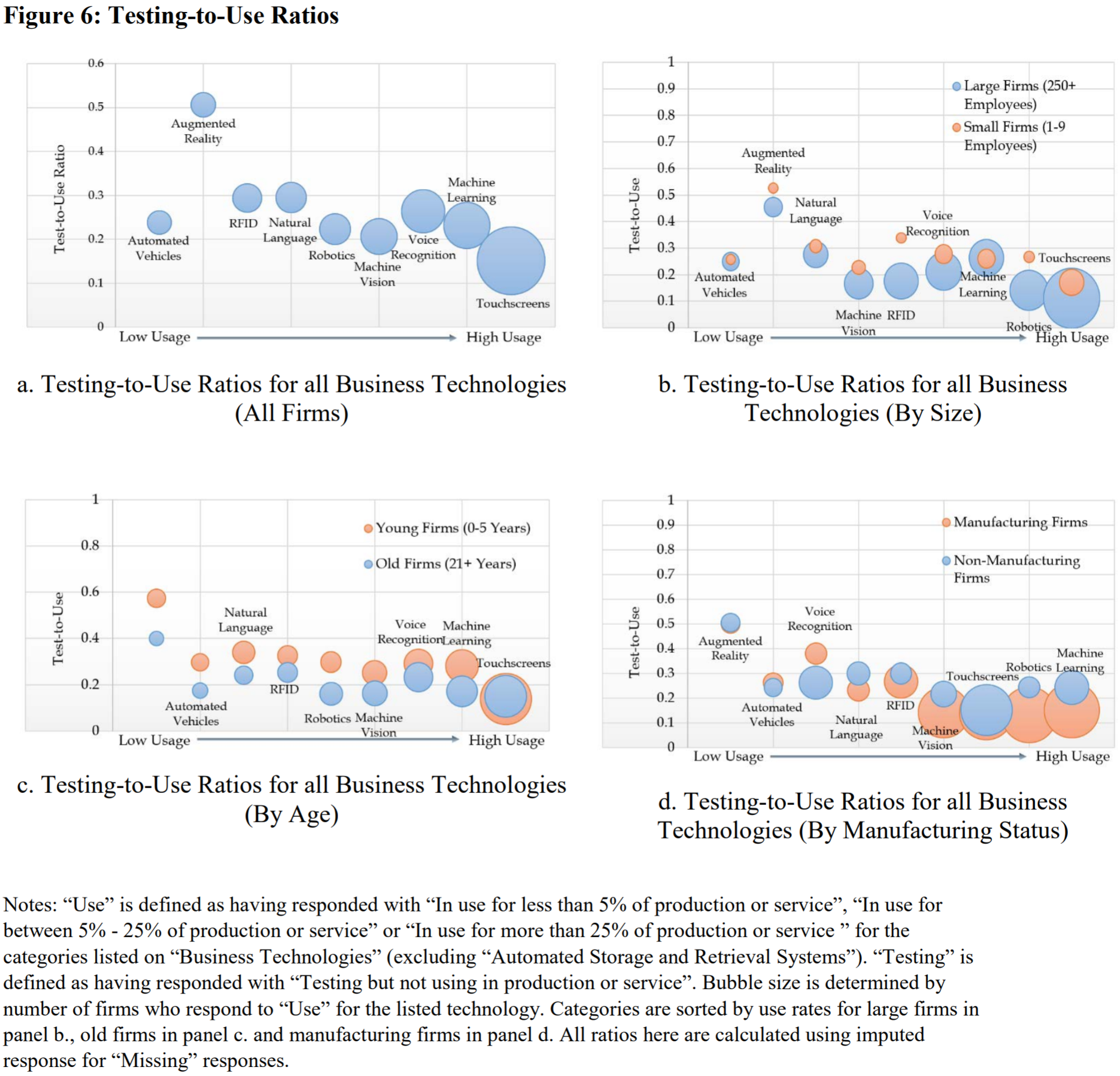Manufacturing Leads the Adoption of Advanced Technologies
 Testing-to-Use Ratios for Advanced Business Technologies. Credit: NBER Working Paper 28290. Zolas et. al
Testing-to-Use Ratios for Advanced Business Technologies. Credit: NBER Working Paper 28290. Zolas et. al
A popular misconception is that industrial companies are out-of-touch with the latest in technology. While that may be the case for some smaller manufacturers, the data in Figure 6 above shows that manufacturing firms are leading consumers of advanced technologies. Not only do manufacturers test advanced technology often, they get worthwhile technologies into production (large circle and lower test-to-use ratio). This directly aligns with my experiences that manufacturers are adept at testing technology, quantifying financial impact, and integrating into production through various continuous improvement processes. Additional figures and discussion within the working paper, “Advanced Technologies Adoption and Use by U.S. Firms: Evidence from the Annual Business Survey”, gives even more evidence that manufacturers set the frontier for many advanced technologies. The link is below.
Of the nine advanced technologies in Figure 6, what are some of the use cases within industrial operations that make them so prevalent?
- Machine Learning - predictive maintenance, predictive in-line quality, demand forecasting, asset performance management
- Robotics - welding, paint, lifts, packing, palletizing, pick and place, furnace loading/unloading, material handling, etc.
- Touchscreens - controlling machines with human-machine interfaces (HMIs); tablets for real-time KPIs and diagnosing asset health; inventory management
- Machine Vision - automated quality inspections, product configuration management, debris identification
- RFID - inventory management, maintenance, control systems
- Natural Language Processing - product feedback analysis
- Voice Recognition - machine control
- Automated Vehicles - material transport
- Augmented Reality - machine operator training
Video of the Week
Appliance Park Dishwasher Line Expansion
Assembly Line
Advanced Technologies Adoption and Use by U.S. Firms: Evidence from the Annual Business Survey
While robots are usually singled out as a key technology in studies of automation, the overall diffusion of robotics use and testing is very low across firms in the U.S. The use rate is only 1.3% and the testing rate is 0.3%. These levels correspond relatively closely with patterns found in the robotics expenditure question in the 2018 ASM. Robots are primarily concentrated in large, manufacturing firms. The distribution of robots among firms is highly skewed, and the skewness in favor of larger firms can have a disproportionate effect on the economy that is otherwise not obvious from the relatively low overall diffusion rate of robots. The least-used technologies are RFID (1.1%), Augmented Reality (0.8%), and Automated Vehicles (0.8%). Looking at the pairwise adoption of these technologies in Table 14, we find that use of Machine Learning and Machine Vision are most coincident. We find that use of Automated Guided Vehicles is closely associated with use of Augmented Reality, RFID, and Machine Vision.
Precision of Digital Twin Data Models Hold Key to Success
As the industrial sector turns to digital twin technology for operational efficiency, digital twin data model accuracy is key to success of digital replicas.
Industrial automation unites the best of OT and IT
As operational and information technology roles progressively overlap in the industrial automation space, a hybrid operational technology/information technology (OT/IT) solution becomes increasingly necessary.
Speeding the Adoption of Additive Manufacturing
Additive manufacturing (AM), or 3D printing offers a number of potential innovations in product design, while its flexible manufacturing capabilities can support a distributed manufacturing model - helping to unlock new business potential. However, when companies begin to consider all that is needed to make additive a reality— such as generative design, part consolidation, and topology optimization—it becomes clear that the traditional ways of designing and manufacturing parts are falling away.
Stanford researchers propose AI that figures out how to use real-world objects
One longstanding goal of AI research is to allow robots to meaningfully interact with real-world environments. In a recent paper, researchers at Stanford and Facebook took a step toward this by extracting information related to actions like pushing or pulling objects with movable parts and using it to train an AI model. For example, given a drawer, their model can predict that applying a pulling force on the handle would open the drawer.
Facilitating IoT provisioning at scale
Whether you’re looking to design a new device or retrofitting an existing device for the IoT, you will need to consider IoT provisioning which brings IoT devices online to cloud services. IoT provisioning design requires decisions to be made that impact user experience and security for both network commissioning and credential provisioning mechanisms which configure digital identities, cloud end-points, and network credentials so that devices can securely connect to the cloud.
Surge Demand
The new GM logo is unveiled to mixed reviews. Elon Musk passes Bezos to become the world’s richest. Teladyne acquires Flir Systems for $8B. A renewable-energy arms race commences. A chip guru finds a new home at AI startup Tenstorrent.
